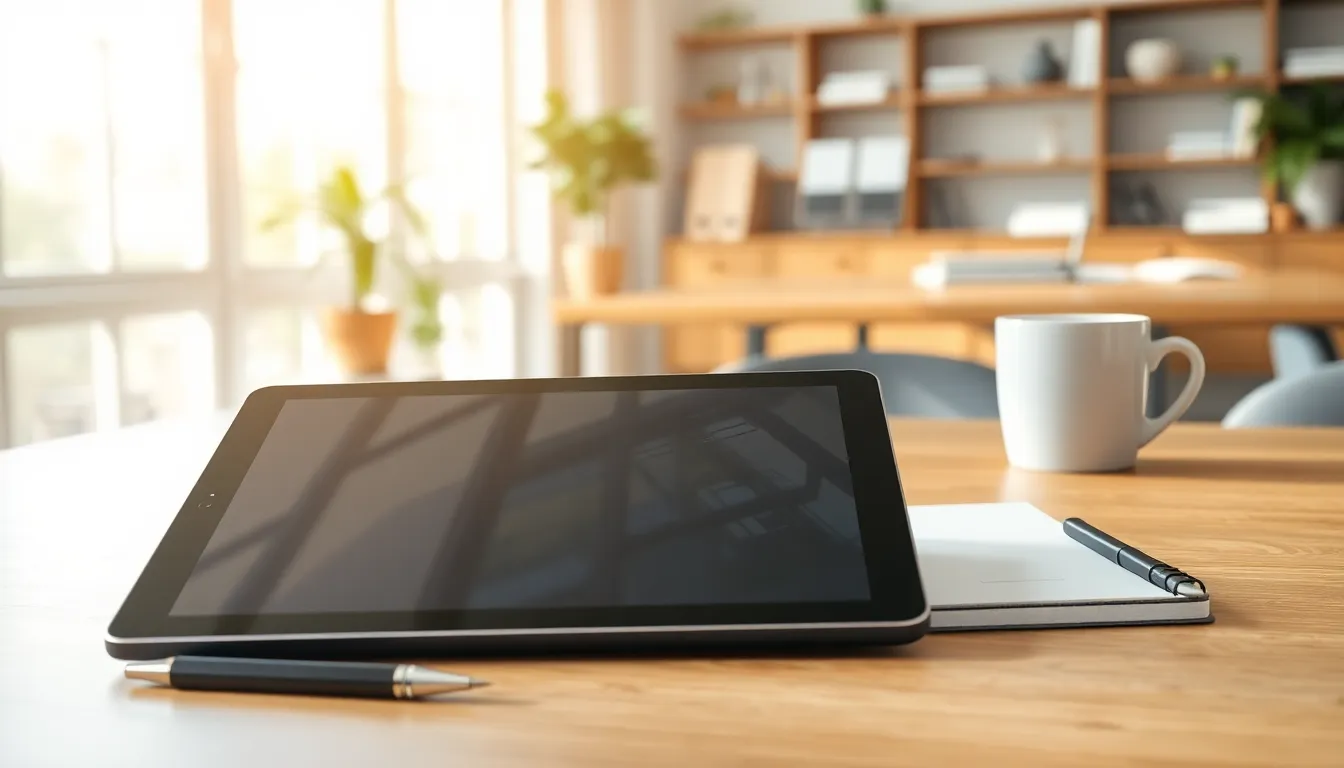Table of Contents
ToggleIn a world where tablets reign supreme, choosing the right one can feel like finding a needle in a haystack—or maybe more like searching for Wi-Fi in a coffee shop. With endless options and features that sound like they belong in a sci-fi movie, it’s easy to get overwhelmed. Fear not! This guide dives into the nitty-gritty of tablet evaluations, helping tech enthusiasts and casual users alike navigate the digital jungle.
Imagine having a trusty sidekick that fits in your bag, ready to help with everything from binge-watching your favorite shows to tackling that never-ending to-do list. With the right tablet, you can do it all—without sacrificing style or performance. So grab a snack, settle in, and let’s explore the ins and outs of tablet evaluations, ensuring you make an informed choice that’ll leave you feeling like a tech-savvy superhero.
Overview of Tablet Evaluations
Evaluating tablets involves several key factors that influence both functionality and user experience. Performance remains a critical aspect. Processing speed, memory capacity, and battery life play pivotal roles in how effectively a tablet operates for both casual and intensive tasks.
Design and build quality significantly affect user satisfaction. Materials used, weight, and ergonomics determine a tablet’s comfort during extended use. Weight may matter more for users who frequently travel or use their device on the go.
Display quality should also receive attention. Screen resolution, brightness, and color accuracy impact viewing experiences, especially for tasks like video streaming or photo editing. An excellent display enhances enjoyment and increases productivity.
Software ecosystem matters greatly when considering a tablet. Users often choose between Android, iOS, and Windows platforms. Each operating system provides unique features, applications, and services. Compatibility with other devices may influence software preference.
Connectivity options such as Wi-Fi, Bluetooth, and cellular capabilities also require evaluation. Tablets with diverse connectivity options offer flexibility for users, allowing access to internet services in various environments. These functionalities cater to a severe need for versatility.
Storage capacity affects usability, particularly for media consumption or app-heavy usage. Users should consider both internal storage and cloud integration when evaluating their options. A balance between these factors leads to optimal tablet performance.
Lastly, price represents an essential decision factor. Budget constraints will guide selections, but understanding value for money is crucial. Affordable tablets might offer decent performance, while premium models provide advanced features appealing to power users.
Key Evaluation Criteria

Evaluating a tablet requires focusing on several crucial criteria to ensure an optimal choice. Each area contributes significantly to overall performance and user satisfaction.
Performance Metrics
Processing speed directly impacts how smoothly a tablet operates during tasks. Look for devices with a minimum of 4 GB RAM for multitasking efficiency. Additionally, consider the processor brand and type, as some models cater to gaming or heavy applications better than others. Graphics performance matters for those who enjoy gaming or video editing. Benchmark scores can provide insights into performance stability.
Display Quality
Screen resolution significantly influences viewing experiences. For a clear image, aim for at least 1920 x 1200 pixels. Brightness levels also play a role in outdoor usability; higher brightness enhances visibility under direct sunlight. Color accuracy remains vital for media consumption, particularly for photography and video editing. Lastly, consider the screen size, with larger displays offering more immersive experiences.
Battery Life
Battery longevity affects user convenience, determining how long a device lasts on a single charge. Many tablets now feature batteries rated for at least 8 hours of usage. Fast charging technology can be beneficial for those on the go, allowing quicker power-ups. Consider how intensive tasks, like gaming or streaming, drain the battery faster. Evaluate user reviews for real-world battery performance under various conditions.
User Experience
User interface design enhances overall satisfaction with a tablet. Intuitive navigation simplifies accessibility to apps and settings. Customization options allow users to tailor their experience, catering to personal preferences. Regular software updates ensure security and introduce new features. Compatibility with accessories improves versatility, enhancing functionality for different tasks.
Popular Tablets Reviewed
Tablets cater to a wide range of needs, from high-end performance to budget-friendly options. Here’s a detailed look at popular tablets across different categories.
Premium Tablets
Premium tablets deliver exceptional performance and features. Products like the Apple iPad Pro and Samsung Galaxy Tab S8 provide powerful processors and stunning displays. The iPad Pro features Apple’s M1 chip, offering seamless multitasking and impressive graphics capabilities. Galaxy Tab S8 includes a vibrant AMOLED display for superior color accuracy. Both devices support stylus input, enhancing productivity for creative tasks. Battery life typically exceeds 10 hours, allowing users to work throughout the day without interruptions. Users looking for high-quality build and design will find these options attractive.
Budget Tablets
Budget tablets make technology accessible without sacrificing essential features. Models like the Amazon Fire HD 10 and Lenovo Tab M10 Plus offer good performance at competitive prices. Users enjoy decent processing power suitable for browsing and streaming. The Fire HD 10 boasts a full HD display, perfect for enjoying videos and reading. Lenovo Tab M10 Plus provides a versatile entertainment experience, complete with dual speakers for enhanced sound. Battery longevity generally reaches around 8 hours, making them ideal for casual users. Affordability and functionality ensure these devices fit various lifestyles.
2-in-1 Tablets
2-in-1 tablets combine the flexibility of a tablet with the functionality of a laptop. The Microsoft Surface Pro 9 and HP Envy x2 stand out in this category, offering detachable keyboards and robust performance. Surface Pro 9 includes a vibrant PixelSense display and supports Windows 11, providing a familiar desktop experience. HP Envy x2 prioritizes portability with a lightweight design, suitable for users on the go. Both models accommodate stylus input for creative projects and note-taking. Battery life usually lasts up to 10 hours, allowing extended productivity sessions. These hybrids serve as effective tools for both work and leisure.
Methodology of Evaluations
Evaluations of tablets incorporate a multi-faceted approach that focuses on essential performance metrics. Performance aspects include processing speed, memory capacity, and battery life, which affect both casual and intensive tasks. Each metric is assessed to determine how well a tablet meets user needs.
Design and build quality influence user satisfaction. Comfort during extended use matters, so evaluations consider weight, dimensions, and materials used in construction. These factors can determine the tablet’s portability and long-term viability.
Display quality significantly impacts user experience. Screen resolution, brightness, and color accuracy play crucial roles in viewing enjoyment. Evaluators often use specific metrics, such as aiming for a resolution of at least 1920 x 1200 pixels, to ensure clarity and appeal.
The software ecosystem is another focal point. Choosing between Android, iOS, and Windows platforms involves evaluating unique features and compatibility with desired applications. Each operating system’s interface and capabilities receive thorough inspection.
Connectivity options are vital for flexibility. Assessments include available Wi-Fi standards, Bluetooth version, and cellular capabilities. Tablets that support the latest standards provide seamless internet access and peripheral compatibility.
Storage capacity receives careful consideration, especially for users engaged in media consumption or app-heavy usage. Evaluators look at both internal storage options and potential for cloud integration. Balancing these aspects ensures sufficient space for average user needs.
Price evaluations weigh budget constraints against the overall value. Evaluators assess performance relative to cost, ensuring favorable price-to-performance ratios. Looking at multiple models ensures that users can find suitable devices within their budget while meeting performance expectations.
Prioritizing these aspects creates a comprehensive framework for tablet evaluations, guiding consumers toward informed decisions.
Navigating the tablet market can be overwhelming but understanding key evaluation criteria simplifies the process. By focusing on performance, display quality, and user experience, individuals can identify a tablet that truly meets their needs.
Whether it’s a premium device for creative tasks or a budget-friendly option for casual use, making informed choices enhances overall satisfaction. With the right tablet in hand, users can enjoy a seamless blend of productivity and entertainment. Ultimately, the right evaluation approach empowers consumers to find a device that fits their lifestyle and preferences.




